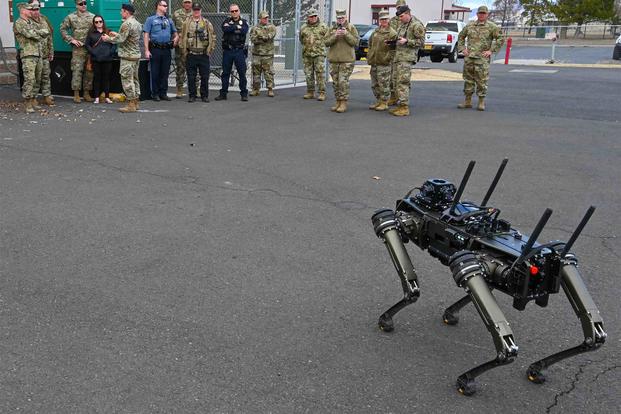The Portland Air National Guard's 142nd Security Forces Squadron became the first Guard unit in the nation to receive a new "robot dog" and plans to test the technology for surveillance and base security operations.
The Oregon-based Guard unit's "Quad-legged Unmanned Ground Vehicle," otherwise known as the Q-UGV, can conduct video surveillance and patrol a fence line without putting airmen in danger. Robot dogs first made an appearance at active-duty bases last year, and the equipment and testing are now trickling down to the Guard.
The 142nd received the Q-UGV at the start of the year, according to the base's public affairs office, and the security forces have started demonstrating the technology to other units throughout the state this past month.
Read Next: Coast Guard Nominates First Female Service Chief; Vice Commandant to Step Up in May
"We've just been testing it by programming in different routes and seeing how the GPS works in our situation here at the base," Tech. Sgt. Jamie Cuniff of the 142nd told ABC's KATU TV station in Portland last month.
"[We're] also putting it through different terrain tests, up and down hills and stairs, seeing how it interacts with vehicles and how vehicles interact with it and the people on the installation," he said.
The Q-UGV, designed by Ghost Robotics and Immersive Wisdom, has a variety of cameras and sensors on board and can climb up rugged terrain as well as high-step over obstacles.
A single charge powers the robot dog for seven hours. It is controlled remotely by a security forces operator on the base, but the plan is to eventually have the Q-UGV set on a pre-programed path to run autonomously.
Last year, the 325th Fighter Wing out of Tyndall Air Force Base in Florida became the first in the Defense Department to acquire the technology. It received four Q-UGV's for base security operations.
"I can say that there is definitely a lot of interest in the capabilities of the technology," Master Sgt. Krystoffer Miller of the 325th Security Forces Squadron said in a news release last year. "I'm hopeful that other units will see some of the successes at Tyndall and will continue to explore the use of nonconventional tactics."
The 142nd in Portland has taken the Q-UGV to other bases, such as Kingsley Field in Klamath Falls, Oregon, last month, to showcase how it could help with routine base duties.
"We're also going to have the capability to speak to people through the robot," Cuniff told KATU. "So if we do encounter an individual, we can engage with them verbally, remotely, from another place on base, while we're responding at the same time. It's a simultaneous response capability that we've never seen before."
The Q-UGVs in Portland and at Tyndall are unarmed but, notably, Ghost Robotics displayed one of the robot dogs fitted with a rifle at the Association of the United States Army's 2021 annual conference.
The use of autonomous weapons and equipment in the military has gained interest and popularity over the last decade.
Ghost Robotics' Q-UGV resembles the four-legged creation of Boston Dynamics, a yellow robot named Spot, which has been in viral videos from the company since 2019.
Ghost Robotics also partnered with the Department of Homeland Security earlier this year to test its robot dogs for use on the border.
The news made many Twitter users compare the Q-UVG to the killer dog robot from the "Metalhead" episode of "Black Mirror," in which a woman runs through the desert to escape the clutches of the autonomous villain.
The larger discussion of the role of autonomous systems in the military, and how they will affect future jobs in the ranks, is just beginning to take shape as more inventions reach the field.
But Henrik Christensen, director of the Institute for Contextual Robotics at UC San Diego, told Military.com it's unlikely that we'll see widespread replacement of security forces by robot dogs in the near future.
"I think the trend we're seeing is we're trying to automate what are called the dirty, dull and dangerous tasks," Christensen said. "The dull task is going around and patrolling ... but we're still going to need the people, because if something is detected, we're not going to have dogs that can automatically do intervention."
-- Thomas Novelly can be reached at thomas.novelly@military.com. Follow him on Twitter @TomNovelly.
Related: Robot Security Dogs Have Arrived at Tyndall Air Force Base













